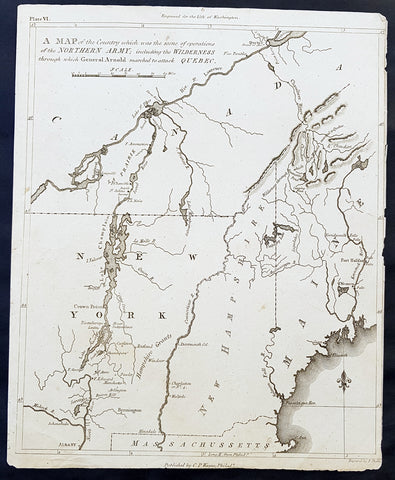
Sydney Hall (1818 - 1860)
Profile :
Sydney Hall was responsible for many fine maps in many publications during the early 19th century. His eye for detail was greatly admired and much copied and although his maps were not decorative, in the 17th and 18th century style, they served their purpose well during a period when maps were used much more for purpose than decoration
Sydney Hall (1)
1804 J Marshall Original Antique American Revolutionary War Map Battle of Quebec
- Title : A Map of the Country which was the scene of operations of the Northern Army; including the Wilderness through which General Arnold marched to attack Quebec
- Size: 11in x 9in (280mm x 225mm)
- Ref #: 35091
- Date : 1804
- Condition: (A) Very Good Condition
Description:
This fine original copper-plate engraved antique map of the Battle of Quebec - covering New York, New Hampshire and Quebec Canada - in December 1775 during the American Revolutionary War, was published in the first 1804 edition of John Marshalls The Life of George Washington, Commander in Chief of the American Forces, during the War which established the Independence of his Country.............
General Definitions:
Paper thickness and quality: - Heavy and stable
Paper color : - off white
Age of map color: -
Colors used: -
General color appearance: -
Paper size: - 11in x 9in (280mm x 225mm)
Plate size: - 11in x 9in (280mm x 225mm)
Margins: - Min 1/8in (2mm)
Imperfections:
Margins: - Right margin cropped close to border
Plate area: - Light vertical crease as issued
Verso: - None
Background:
The Battle of Quebec was fought on December 31, 1775, between American Continental Army forces and the British defenders of Quebec City early in the American Revolutionary War. The battle was the first major defeat of the war for the Americans, and it came with heavy losses. General Richard Montgomery was killed, Benedict Arnold was wounded, and Daniel Morgan and more than 400 men were taken prisoner. The city\'s garrison, a motley assortment of regular troops and militia led by Quebec\'s provincial governor, General Guy Carleton, suffered a small number of casualties.
Montgomery\'s army had captured Montreal on November 13, and early in December they joined a force led by Arnold, whose men had made an arduous trek through the wilderness of northern New England. Governor Carleton had escaped from Montreal to Quebec, the Americans\' next objective, and last-minute reinforcements arrived to bolster the city\'s limited defenses before the attacking force\'s arrival. Concerned that expiring enlistments would reduce his force, Montgomery made the end-of-year attack in a blinding snowstorm to conceal his army\'s movements. The plan was for separate forces led by Montgomery and Arnold to converge in the lower city before scaling the walls protecting the upper city. Montgomery\'s force turned back after he was killed by cannon fire early in the battle, but Arnold\'s force penetrated further into the lower city. Arnold was injured early in the attack, and Morgan led the assault in his place before he became trapped in the lower city and was forced to surrender. Arnold and the Americans maintained an ineffectual blockade of the city until spring, when British reinforcements arrived.
In the battle and the following siege, French-speaking Canadians were active on both sides of the conflict. The American forces received supplies and logistical support from local residents, and the citys defenders included locally raised militia. When the Americans retreated, they were accompanied by a number of their supporters; those who remained behind were subjected to a variety of punishments after the British re-established control over the province.

